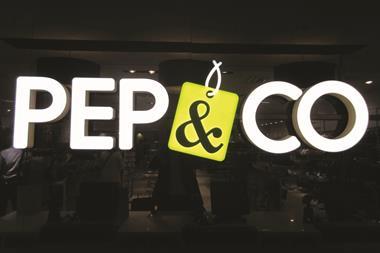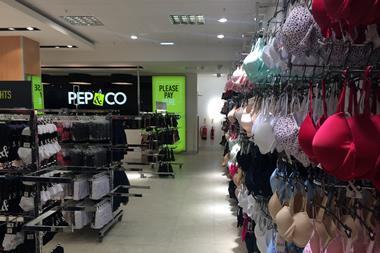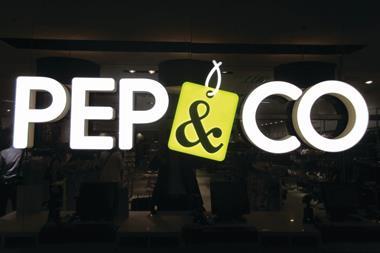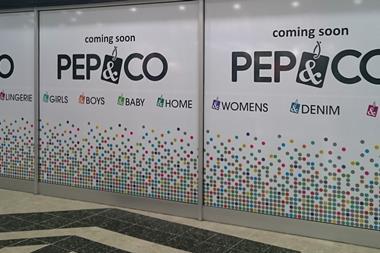Fashion retailer Pep&Co will hit the high street this summer, challenging rival value players. Retail Week speaks to managing director Adrian Mountford ahead of its 50-store launch.
A new fashion retail name might seem like the last thing the high street needs.
From mid-market giants such as Marks & Spencer and Next, through to value powerhouse Primark, apparel is one of retail’s most crowded and competitive markets.
But the people behind soon-to-launch Pep&Co, including former Asda boss Andy Bond and South African retail tycoon Christo Wiese, nevertheless think they have spotted a gap in the market.
Pep&Co managing director Adrian Mountford, a former Matalan and Sainsbury’s executive, maintains Pep&Co will carve out a niche for itself by creating a “genuine discount retail format for fashion and families”.
While some might think that Primark is already fulfilling that pretty well, Mountford insists Pep&Co is “definitely not” competing with the value fashion leader and its offer and locations will be different.
He says: “We’re targeting a family shopper who’s got kids. Maybe she used to shop at Primark, but actually doesn’t want to roll a buggy into the busier towns. Maybe she’s a little scared of the fashion in Primark right now.”
Like Primark though, Mountford says that it is important for customers to be able to spend a little and walk out with a lot. “We know customers love walking out with a bag full of stuff and they’ve only spent 20 quid.”
Pep&Co’s discount offering will mainly comprise fashion, but will also include homewares. Mountford explains: “Fashion-home. Not furniture. Not huge items they couldn’t carry down the high street. But candles, frames, cushions, throws. Things to dress up their home, like they dress up themselves.”
Because of that product mix, Mountford hopes mums will indulge in impulse “guilt-free” buys as they walk through the store buying clothes for their children.
Pep&Co roll out
The intention is for Pep&Co to launch 50 stores measuring between 3,500 sq ft and 5,500 sq ft across the UK in July.
But Mountford says the retailer has its eyes on 500 towns around the country in which it hopes to trade within the next five to 10 years.
While the 50 stores will miss out on the summer fashion lines, the intention is for them to have ironed out any post-launch creases in time for the kick-off of autumn/winter in September, as peak nears.
By the end of February, the retailer will have secured its first 25 leases, but the journey has not been easy. Mountford says the most obvious way to secure a large number of stores for launch was to acquire another business which already had a similar UK footprint, which Pep&Co got very close to doing.
Over the course of one year, the retailer had agreed on acquisition terms and gone into due diligence, “but at the 11th hour and 59th minute it fell through last summer,” says Mountford.
Following that disappointment, Mountford and Bond dusted themselves down and decided to embark on Plan B –starting from scratch.
“It’s probably easier to take an infrastructure that already exists with the stores – the team, IT, distribution centre, processes, systems - and kind of plug your idea into that, but it became apparent that that wasn’t going to happen,” he explains.
Thanks to the backing from Weise’s investment company Pepkor, Mountford says it was possible to take time to get the proposition right and find the best locations.
Regenerating the high street
He says Pep&Co needs its 50 shops to be in particular clusters of high streets to ensure that from a logistics and store management perspective, the shops aren’t hundreds of miles away from each other.
And pointing to areas such as North and South Wales, as well as East Anglia, Mountford says such locations appeal to Pep&Co because they don’t have large towns nearby as rival shopping destinations.
“These towns are regenerating themselves and it would be great to be a part of that,” says Mountford.
He describes high streets which have all been through a similar journey, sometimes going from thriving market towns to vacant shells as the Woolworths and HMVs started to close.
“Then the poundshops moved in, and that started to generate the high street,” he explains, describing how more restaurants and cafes started to open up around the new bargain stores.
“Playing some part in those local communities will be where our lifeblood will be,” he says.
While Mountford says the regeneration has started in the south of the country, he is seeing this trend in most towns he visits.
“When I stop and have a cup of coffee, it’s full of people who are our customers, with buggies, one or two children, catching up with their friends, they might not have a lot of money but actually it’s a bit of a social release to get out of the house, you can walk up to town and on the way back if we can tempt them into our store with our fantastic prices and product, then maybe we can succeed anywhere.”
Start-up mentality
With most of the Pep&Co staff coming from retail backgrounds, they are all expected to chip in with the development of the business. The morning of the interview, Mountford says he was approving candle scents and colours for carrier bags. “It’s completely diverse, I’m the managing director and home buyer at the moment- you can’t be precious in this type on environment, we’re trying to land everything from scratch,” he says describing Pep&Co as having a start-up mentality.
Online offering
While Pep&Co intends to have a website at launch to show off its range of products, it won’t be a transactional site. Mountford says e-commerce is important to implement further down the line, but can’t put a date on when that might occur.
“There’s a lot to do – I have a very long list,” he says. “The most important thing is that we launch it well.”
After launch it’s up to Mountford and his team to take a look at the to-do list. “Whatever it is - that goes for online and anything else – there’s a list of a million things we could do, but then we get distracted and we don’t do some of the basic things well.”


























2 Readers' comments